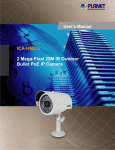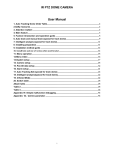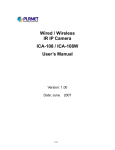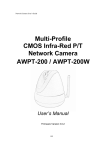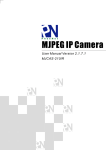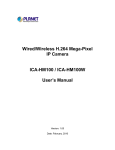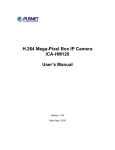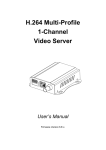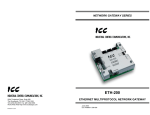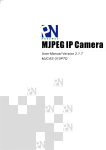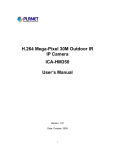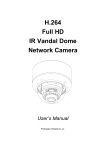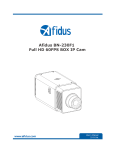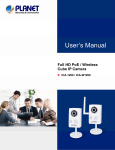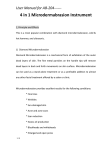Download User Manual - Economizadores
Transcript
User Manual H.264 Multi-Stream High-Speed OSD Speed Dome Network Camera 2009-11-20 Software Version 5.0.1 Owner's Record The model and serial numbers are on the device. Record these numbers in the spaces provided below. Refer to these numbers whenever you call upon your dealer regarding this product. Model No. ____________________ Serial No. ____________________ To prevent fire or shock hazard, do not expose the unit to rain or moisture. For AC Adaptor to avoid electrical shock, do not open the cabinet. Refer servicing to qualified personnel only. Notice: The changes or modifications not expressly approved by the party responsible for compliance could void the user’s authority to operate the equipment. For customers in the U.S.A. This equipment has been tested and found to comply with the limits for a digital device, pursuant to Part 15 of the FCC Rules. These limits are designed to provide reasonable protection against harmful interference in a residential installation. This equipment generates, uses, and can radiate radio frequency energy and, if not installed and used in accordance with the instructions, may cause harmful interference to radio communications. However, there is no guarantee that interference will not occur in a particular installation. If this equipment does cause harmful interference to radio or television reception, which can be determined by turning the equipment off and on, the user is encouraged to try to correct the interference by one or more of the following measures: – Reorient or relocate the receiving antenna. – Increase the separation between the equipment and receiver. – Connect the equipment into an outlet on a circuit different from that to which the receiver is connected. – Consult the dealer or an experienced radio/TV technician for help. You are cautioned that any changes or modifications not expressly approved in this manual could void your authority to operate this equipment. The shielded interface cable recommended in this manual must be used with this equipment in order to comply with the limits for a digital device pursuant to Subpart B of Part 15 of FCC Rules. 2/98 Declaration of Conformity This device complies with part 15 of the FCC Rules. Operation is subject to the following two conditions: (1) this device may not cause harmful interference, and (2) this device must accept any interference received, including interference that may cause undesired operation. NOTICE TO USERS © 2006~9 All rights reserved. This manual or the software described herein, in whole or in part, may not be reproduced, translated or reduced to any machine readable form without prior written approval. WE PROVIDES NO WARRANTY WITH REGARD TO THIS MANUAL, THE SOFTWARE OR OTHER INFORMATION CONTAINED HEREIN AND HEREBY EXPRESSLY DISCLAIMS ANY IMPLIED WARRANTIES OF MERCHANTABILITY OR FITNESS FOR ANY PARTICULAR PURPOSE WITH REGARD TO THIS MANUAL, THE SOFTWARE OR SUCH OTHER INFORMATION. IN NO EVENT SHALL WE BE LIABLE FOR ANY INCIDENTAL, CONSEQUENTIAL OR SPECIAL DAMAGES, WHETHER BASED ON TORT, CONTRACT, OR OTHERWISE, ARISING OUT OF OR IN CONNECTION WITH THIS MANUAL, THE SOFTWARE OR OTHER INFORMATION CONTAINED HEREIN OR THE USE THEREOF. We reserve the right to make any modification to this manual or the information contained herein at any time without notice. The software described herein may also be governed by the terms of a separate user license agreement. 3/98 Table of Contents 1. 2. 3. 4. 5. 6. 7. Overview ..................................................................................................................... 6 Introduction................................................................................................................. 6 Features ....................................................................................................................... 6 Minimum System Requirements................................................................................. 7 Package Contents........................................................................................................ 8 Connections................................................................................................................. 9 Hardware Installation ................................................................................................11 Preparation ............................................................................................................... 12 5.1 Search and Set up by IPWizard II....................................................................... 12 Search................................................................................................................ 12 View .................................................................................................................. 13 LAN .................................................................................................................. 13 Wireless............................................................................................................. 15 5.2 Using UPnP of Windows XP or Vista ................................................................. 16 5.3 Install the Device behind a NAT Router ............................................................. 17 5.4 Access the device from the Internet Explorer for the first time.......................... 18 5.5 Enter Camera Setting as an Administrator.......................................................... 19 5.6 Enter Camera Setting as an User ........................................................................ 19 Operating the Network Camera ................................................................................ 20 6.1 Monitor Video Section ........................................................................................ 20 6.2 Video Stream....................................................................................................... 20 6.3 Streaming Protocol.............................................................................................. 20 6.4 Language............................................................................................................. 21 6.5 2-Way Audio ....................................................................................................... 21 6.6 Image Flip ........................................................................................................... 21 6.7 Image Mirror....................................................................................................... 21 6.8 Status Bar ............................................................................................................ 21 6.9 PTZ Control ........................................................................................................ 22 6.10 ActiveX Control ................................................................................................ 23 Digital Zoom..................................................................................................... 23 Snapshot............................................................................................................ 24 Record ............................................................................................................... 25 Voice ................................................................................................................. 25 Statistics ............................................................................................................ 26 About................................................................................................................. 26 Administrating the Device......................................................................................... 27 7.1 System Setting .................................................................................................... 27 7.1.1 Network: Configure Network settings ..................................................... 27 7.1.2 Camera: Adjust Camera parameters......................................................... 37 7.1.3 System: Configure and maintain system.................................................. 41 7.1.4 Video: Configure profile .......................................................................... 46 7.1.5 Audio: Audio parameters ......................................................................... 48 7.1.6 User: Manage user name, password and login privilege ......................... 49 4/98 7.1.7 E-Mail: Setup E-Mail configuration ........................................................ 50 7.1.8 Object detection: Setup Object detection................................................. 52 7.1.9 Event Server: Setup FTP/TCP/HTTP/SAMBA server configuration...... 53 7.1.10 Event Schedule: Configure the event schedule...................................... 57 Appendix A: Alarm I/O Connector.................................................................................... 62 Appendix B: Troubleshooting & Frequently Asked Questions .......................................... 64 Appendix C: PING IP Address.......................................................................................... 69 Appendix D: Bandwidth Estimation.................................................................................. 70 Appendix E: Specifications ............................................................................................... 71 Appendix F: Configure Port Forwarding Manually ......................................................... 73 Appendix G: DDNS Application ....................................................................................... 76 Appendix H: Power Line Frequency................................................................................. 83 Appendix I: 3GPP ............................................................................................................. 84 Appendix J: Enable UPnP of Windows XP ....................................................................... 85 Appendix K: Speed dome Installation guidance ............................................................. 89 Appendix L: Keyboard control ........................................................................................ 97 5/98 1. Overview This user’s guide explains how to operate the Network Camera from a computer. User should read this manual completely and carefully before you operate this device. Introduction This camera is an extraordinary and fully scalable surveillance device. Because the Network Cameras can be plugged into your existing local area network (LAN), you will potentially save thousands of dollars from unnecessary cabling. The device is accessible via the LAN or Internet connection. Connect your device directly to a local area network or xDSL modem, and with Microsoft® Internet Explorer you get instant, on demand video streams. Within minutes you can set up the device to capture a video sequence to a PC. The live video can be uploaded to a website for the world to see. Features De-noise to enhance image quality Composite video output Easy installation with setup wizard UPnP device discovery and NAT router transversal for easy installation H.264, MPEG4 and JPEG triple compression simultaneously 9 type video stream encoder simultaneously UDP / TCP / HTTP protocols selectable and auto-trial Supports video/audio multi-casting 3GPP for 3G mobile remote application 30 fps for all resolutions External MIC input Audio line out Two-way audio Digital zoom Intelligent motion detection up to 10 zones Voice alerting while motion triggered Image transmission using an FTP or e-mail for event Sensor input and alarm output 6/98 DDNS and PPPoE On-line firmware upgrade Memorize 256 camera position 8 set privacy area Coordinate, optic lens and temperature display Day / Night mode by time schedule or auto shift Auto/Manual mode on focus/white balance/brightness/shutter speed/iris Wide Dynamic Range camera (Optional: FCB Series) Back light compensation Adjustable zoom/focus speed Auto scan between two position 360 degree horizontal scanning with adjustable scan speed and pausing time using frame scan 8 set timer action Power on action IEEE 802.3af Power over Ethernet Minimum System Requirements Microsoft Internet Explorer 6.0 or later Microsoft Media Player 11.0 or later (to playback recorded file) VGA Monitor resolution 1024 x 768 or higher Pentium-4 2.0 GHz or higher Memory Size: 512MB or more Windows XP, Vista 7/98 2. Package Contents User can find the following items in the package as below: Item Descriptions 1. PVC TAPE 2.Gloves 3. 12V DC1A Power Supply 4. Indoor Speed DOME: 24V/1.25A ; Outdoor Speed Dome: 24V/3A 4. User’s Manual CD provides important information and instructions for operating the IP Speed Dome. 5. User Manual Hardware Installation Guide provides important information and instructions for installing this device. If any of the above items are missing, please contact your dealer immediately. Note: Using a power supply with a different voltage than the one included with the Network Camera will cause damage and void the warranty for this product. 8/98 3. Connections RS485 & DI/DO Video out MIC in Line out 12V DC in RJ45 Factory Default Reset 1. RJ45 LAN socket: Connect to PC or Hub/Switch. Connects to 10Base-T Ethernet or 100Base-TX Fast Ethernet cabling. This Ethernet port built N-Way protocol can detect or negotiate the transmission speed of the network automatically. Please use Category 5 cable to connect the Network Camera to a 100Mbps Fast Ethernet network switch or hub. In the LAN socket, there are two LEDs embedded: LAN LED (green color) This LED will be flashing while network accessing via Ethernet. Power & Wireless LED (orange color) This LED is used to indicate whether DC power is on or not. 9/98 2. RS-485: Connect to a local keyboard controller. DI/ DO: Connect to sensor in and alarm out devices Cable for I/O connectors: Name Cable Color 12VDC Brown/White GND Blue/White D+ Purple/White DGray DI Green/White DO Orange/White Function DC 12V (50mA maximum) GND RS485 data + RS485 data Digital signal input Digital signal output 3. Factory Default Reset This button is used to restore the all factory default settings. Sometimes restarting the device will make the system back to a normal state. However, if the system still got problems after restart, user can restore the factory default settings and install it again. Restore the device: (i) Press the button down continuously. (ii) Hold the button at least 5 seconds and release it. Then the device has been restored to default settings and reboot again. Note: Restoring the factory default setting will lose the all previous settings included IP address forever. User needs to run the IPWizard II program to search the device and configure it to let the device work properly again. 4. DC-in Jack The input power is 12VDC. Note that supply the power to the Network Camera with the power adapter included in package. 5. MIC in (audio in) Connect a microphone to the network camera. 6. Line out (audio out) Connect a loud speaker to the network camera. This function is for voice alerting and two-way audio. 7. Video out (BNC connector) The Network Camera also provides composite video output. User can use BNC video cable to connect the Network Camera with a TV monitor or VCR. 10/98 4. Hardware Installation 1. Fix IP Speed dome to desired location with bracket. (Please see Appendix K for installation guidance) 2. Plug-in Ethernet Cable into RJ45 connector (LAN port) 3. Connect the attached power adapter to camera and plug-in this adapter into power outlet 4. Connect Video BNC connector to a TV set if necessary (to check camera viewing angle and focus) 5. Done 11/98 5. Preparation 5.1 Search and Set up by IPWizard II When you installed the Camera on a LAN environment, you have two easy ways to search your Cameras by IPWizard II or UPnP™ discovery. Here is the way to execute IPWizard II to discover Camera’s IP address and set up related parameter in a Camera. Search When launch the IPWizard II, a searching window will pop up. IPWizard II is starting to search Network Cameras on the LAN. The existed devices will be listed as below. User may click on the “SEARCH” button to search the network cameras. 12/98 View If IPWizard II finds network devices, View button will be available. Please select the device you want to view and click the View button. Then you could see the video and sound from camera directly. Furthermore you could double click the left button of mouse to link to the network device by browser. LAN In case you want to change the IP related parameters of wired interface, please select the device you want to configure and click the LAN button. Relative settings will be carried out as below. 13/98 You could modify the relative settings of the selected device. Click “ <<” << button will quit the LAN setting procedure and click “ >>” >> button will move to next page as below. In case, you do not want to change username and/or password, then just click “ Submit” Submit button to perform your setting accordingly. Click “ <<” << 14/98 button will go back to previous page. If you like to change username and/or password of the device, just click the check button. Then, the related fields will show up as below. After keying in password, click “ Submit” Submit Click “ <<” << button to perform your setting accordingly. button will go back to previous page. (Note: the username “ admin” is a default username which cannot be modified or removed) Wireless This model does not support wireless function. Therefore, IPWizard II disables this function automatically. 15/98 ® 5.2 Using UPnP of Windows XP or Vista UPnP™ is short for Universal Plug and Play, which is a networking architecture that provides compatibility among networking equipment, software, and peripherals. This device is an UPnP enabled device. If the operating system, Windows XP or Vista, of your PC is UPnP enabled, the Network Camera will be very easy to be found. Please refer to Appendix J to enable UPnP settings only if your operating system of PC is running Windows XP. Note: Windows 2000 does not support UPnP feature. To discover your device, go to your Desktop and click My Network Places. Click the targeted Device. Then Internet Explorer will connect to this Network Camera automatically. 16/98 5.3 Install the Device behind a NAT Router Once installed, the device is accessible on your LAN. To access the device from the Internet you must configure your broadband router to allow incoming data traffic to the device. If the device is installed on the LAN with a router, then it may get a dynamic IP address from the DHCP server. However, if the device wants to be accessed from the WAN, its IP address needs to be setup as fixed IP, also the port forwarding or Virtual Server function of router needs to be setup. However, if your NAT router supports UPnP feature, it can be very easy to achieve NAT traversal automatically. To do this, enable the NAT-traversal feature, which will attempt to automatically configure the router to allow access to the camera. Installing the device with an UPnP router on your network is an easy 2–step procedure: (1) Enable UPnP option of your NAT router (2) Enable UPnP NAT traversal option of the Network Camera (default) (1) Enable UPnP option of your NAT router To use UPnP IGD function (NAT traversal), you need to make sure the UPnP function is enabled in your router. Most new home routers should support this function. Some of routers are default enable and others are not. Please check user’s manual of your NAT router for detail. (2) Enable UPnP NAT traversal option of the Network Camera Refer to Setting Network UPnP page for detail NAT traversal setting. Note that this option is default enabled. 17/98 5.4 Access the device from the Internet Explorer for the first time 1. Start the web browser on the computer and type the IP address of the Network Camera you want to monitor as below: 2. According your browser’s security setting, the IE Web Page may prompt the “Security Warning” window. If so, select “Yes” to install and run the ActiveX control into your PC. Otherwise, the system will load the ActiveX silently. 3. After the ActiveX control was installed and ran, the first image will be displayed. 18/98 5.5 Enter Camera Setting as an Administrator User must login as an administrator if there is need to edit camera setting and control over PTZ. The Login Window of the Camera setting/PTZ control is prompted: Type in your login name and password under “USERNAME” and “PASSWORD” textbox. For the first time use (default value), input the User Name: admin Password: That’s, type in “admin” on the “USERNAME” as a default name and leave PASSWORD textbox blank. Click “OK” button to enter the setting. 5.6 Enter Camera Setting as an User If you enter camera setting as an ordinary User, “Setting” function will be not accessible. 19/98 6. Operating the Network Camera Start-up screen will be as follow no matter an ordinary users or an administrator. 6.1 Monitor Video Section The image shot by the Network Camera is shown here. The date and time are displayed at the top of the window. 6.2 Video Stream The Network Camera support multi-stream for H264, MEPG4 and JPEG simultaneously. User can chose the proper and/or preferred video stream here. 6.3 Streaming Protocol User can select proper streaming protocol according to networking environment. 20/98 6.4 Language The device could provide multiple languages to meet customer’s requirement. 6.5 2-Way Audio The device supports 2-way audio function. User can chose to enable or disable this function by toggling the icon below. : Disable audio uploading function. : Enable audio uploading function. 6.6 Image Flip According to camera position, user might need this function to correct the view angle avoiding upside down. User can chose to enable or disable this function by toggling the icon below. : Disable vertical flip function. : Enable vertical flip function. 6.7 Image Mirror According to camera position, user might need this function to correct the view angle. User can chose to enable or disable this function by toggling the icon below. : Disable vertical flip function. : Enable vertical flip function. 6.8 Status Bar Shows information of the connected device such as encoder format, image resolution, frame per second, and bitrate. 21/98 6.9 PTZ Control Click to display the following control panel: Hide PTZ control Camera direction ZOOM FOCUS Camera speed Preset point Run Tour Tour Auto pan Hide PTZ control: Click the icon will hide the PTZ control function. Camera direction: Control camera up/down/left/right and home position. Camera speed: Choose the speed of Pan and Tilt. Zoom: Zoom in (Tele) / zoom out (wide) Focus: Focus near/far/auto focus Preset: Add/Update the preset points or go to one of these points. Tour: Select one of the camera tours. Camera tour is comprised by series of preset points. 22/98 Go Tour: Execute the selected camera tour. Auto Pan: Execute the auto pan of camera. While auto pan is running, the camera will swing the camera automatically. Note that the speed of auto pan is fixed and can not be adjustable. 6.10 ActiveX Control The plug-in ActiveX control supports a lot of functions by clicking the left mouse button. Note that this feature only supports on the ActiveX control within Microsfoft® Internet Explorer. On the ActiveX control icon, click the Left Mouse Button, then a menu pop-up. This menu provides features that are unique to the ActiveX control. These features include: • “Digital Zoom”, • “Snapshot”, • “Record”, • “Volume”, • “Statistics”, • “About” Digital Zoom Click Digital Zoom to active this function as above. User can drag or scale the box over the video to adjust zoom ratio and position. 23/98 Snapshot Click Snapshot to activate this function. Press Snapshot button to take a picture. The image file is saved as JPEG format into your local PC. Select Browser, the pop-up window to select the save path and file name prefix, select OK to continue. If you like to retrieve the saved image, select the file to display the saved image by using any one of graph editing tools. 24/98 Record Click Record to activate this function. Press Record button to start recording. The video file is saved as ASF format into your local PC. While you want to stop it, press Stop to stop recording. Select Browser, the pop-up window to select the save path and file name prefix, select OK to continue. After stop recording, list the files, this file is named as Video_yyyymmddhhmmss.avi The ASF files can be display by the standard Windows Media Player, but it needs the DixectX 9.0 or later version to be installed. Voice Click Volume to activate this function. There are two control bars for speaker and microphone volume respectively. Scroll these control bars to adjust the audio attribute. Check the volume mute will mute the speaker output. 25/98 Statistics Click Statistics to activate this function. A window will be popup to show the statistics information of the streaming status. Note that this information is the statistics between the device and your local PC. About Click About to show this ActiveX information. 26/98 7. Administrating the Device 7.1 System Setting This function is only available for user logged into setting as administrator . Click on each menu name to display its setting page. Item Action Network Configure Network settings such as DHCP, DDNS, 3GPP, PPPoE and UPnP Camera Adjust camera parameters and set camera tour System Configure system information, date & time, maintenance, and view system log file. Video Configure bit rate and frame rate of video stream Audio Configure audio parameters, 2-way audio User Setup user name, password and login privilege E-Mail Setup E-Mail configuration Object Detection Setup Object detection Event Server Setup FTP/TCP/HTTP/SAMBA server for event Event Schedule Configure the schedule while event triggered 7.1.1 Network: Configure Network settings Use this menu to configure the network to connect the device and the clients. Network This section provides the menu for connecting the device through Ethernet cable. 27/98 MAC address: Displays the Ethernet MAC address of the device. Note that user can not change it. Obtain an IP address automatically (DHCP): DHCP: Stands for Dynamic Host Configuration Protocol. Enable this checked box when a DHCP server is installed on the network to issue IP address assignment. With this setting, the IP address is assigned automatically. If this device can not get an IP address within limited tries, the device will assign a default IP address, 192.168.0.100, by itself as the default IP address. IP address, Subnet mask, and Gateway: If you do not select Obtain an IP address automatically , then you need to enter these network parameters manually. Obtain DNS from DHCP: DNS: Stands for Domain Name System. Enable this checked box when a DHCP server is installed on the network and provide DNS service. Primary DNS and Secondary DNS: If you do not select Obtain DNS from DHCP, then you need to enter these parameters manually. HTTP Port: The device supports two HTTP ports. The first one is default port 80 and this port is fixed. 28/98 This port is very useful for Intranet usage. The second HTTP port is changeable. Users could assign the second port number of http protocol, and the WAN users should follow the port number to login. If the http port is not assigned as 80, users have to add the port number in back of IP address. For example: http://192.168.0.100:8080 . Therefore, the user can access the device by either http://xx.xx.xx.xx/, or http://xx.xx.xx.xx:xxxx/ to access the device. If multiple devices are installed on the LAN and also required to be accessed from the WAN, then the HTTP Port can be assigned as the virtual server port mapping to support multiple devices. Click “OK” to save and enable the setting. DDNS service DDNS: Stands for Dynamic Domain Name Server Your Internet Service Provider (ISP) provides you at least one IP address which you use to connect to the Internet. The address you get may be static, meaning it never changes, or dynamic, meaning it’s likely to change periodically. Just how often it changes, depends on your ISP. A dynamic IP address complicates remote access since you may not know what your current WAN IP address is when you want to access your device over the Internet. One of the possible solutions to the dynamic IP address problem comes in the form of a dynamic DNS service. A dynamic DNS service is unique because it provides a means of updating your IP address so that your listing will remain current when your IP address changes. There are several excellent DDNS services available on the Internet. One such service you can use is www.DynDNS.org. You’ll need to register with the service and set up the domain name of your choice to begin using it. Please refer to the home page of the service for detailed instructions or refer to Appendix G for more information. If your device is connected to xDSL directly, you might need this feature. However, if your device is behind a NAT router, you will not need to enable this feature because your NAT router should take care of this job. As to xDSL environment, most of the users will use dynamic IP addresses. If users want to set up a web or a FTP server, then the Dynamic Domain Name Server is necessary. 29/98 DDNS: To enable or disable the DDNS service here. Server name: Choose the built-in DDNS server. DDNS Host: The domain name is applied of this device. User name: The user name is used to log into DDNS. Password: The password is used to log into DDNS. PPPoE PPPoE: PPPoE: Stands for Point to Point Protocol over Ethernet A standard builds on Ethernet and Point-to-Point network protocol. It allows your device with xDSL or cable connects with broadband network directly, then your device can dial up and get a dynamic IP address. For more PPPoE and Internet configuration, please consult your dealer or ISP. 30/98 The device can directly connect to the xDSL, however, it should be setup on a LAN environment to program the PPPoE information first, and then connect to the xDSL modem. Power on again, then the device will dial on to the ISP connect to the WAN through the xDSL modem. The procedures are • Connect to a LAN by DHCP or Fixed IP • Access the device, enter Setting Network PPPoE as below PPPoE: To enable or disable the PPPoE service here. User name: Type the user name for the PPPoE service which is provided by the ISP. Password: Type the password for the PPPoE service which is provided by the ISP. IP address, Subnet mask, and Gateway (read only): Shows the IP information got from PPPoE server site. Status: Shows the Status of PPPoE connection. 31/98 Streaming RTSP is a streaming control protocol, and a starting point for negotiating transports such as RTP, multicast and Unicast, and for negotiating codecs. RTSP can be considered a "remote control" for controlling the media stream delivered by a media server. RTSP servers typically use RTP as the protocol for the actual transport of audio/video data. RTSP Port: Choose the RTSP port. The RTSP protocol allows a connecting client to start a video stream. Enter the RTSP port number to use. The default value is 554. RTP Port: Specify the range of transmission port number of video stream. The default range is 50000 to 50999. User can specify a number between 1024 and 65535. UPnP UPnP is short for Universal Plug and Play, which is a networking architecture that provides compatibility among networking equipment, software, and peripherals. This device is an UPnP enabled Video Server. If your operating system is UPnP enabled, the device will automatically be detected and a new icon will be added to “My Network 32/98 Places.” If you do not want to use the UPnP functionality, it can be disabled. In addition, this device also provides UPnP IGD function for NAT traversal easily. Use NAT traversal when your device is located on an intranet (LAN) and you wish to make it available from the other (WAN) side of a NAT router. With NAT traversal properly configured, all HTTP traffic to an external HTTP port in the NAT router will be forwarded to the device. UPnP: To enable or disable the UPnP service here. Friendly Name: Shows the friendly name of this device here. UPnP NAT Traversal When enabled, the device will attempt to configure port mapping in a NAT router on your network, using UPnP™. Note that UPnP™ must be enabled in the NAT router first. Port Range: The port range will open in NAT router. External IP address: Show the IP address and port for WAN access through Internet. If NAT traversal is configured successfully, user can use this IP address and port to access this device. The external IP address is not shown in case NAT traversal function is failed. 33/98 IP Filter You can enter different user’s IP address which are allowing enter or denying by the device. IP Filter: To enable or disable the IP filter function here. IP Filter Policy: Choose the filter policy where is denying or allowing. IP Notification In case the IP address is changed, system is able to send out an email to alert someone if the function is enabled. SMTP Notification (e-mail): If enable this function, then the “Send to” and “Subject” fields need to be filled. Send To: Type the receiver’s e-mail address. This address is used for reply mail. Subject: 34/98 Type the subject/title of the E-mail. TCP Notification: If enable this function, then the “TCP Server“, “TCP Port”, and “Message” fields need to be filled. TCP Server: Type the server name or the IP address of the TCP server. TCP Port: Set port number of TCP server. Message: The message will be sent to TCP server. HTTP Notification: If enable this function, then the fields below need to be filled. URL: Type the server name or the IP address of the HTTP server. HTTP Login name: Type the user name for the HTTP server. 35/98 HTTP Login Password: Type the password for the HTTP server. Proxy Address: Type the server name or the IP address of the HTTP Proxy. Proxy Port: Set port number of Proxy. Proxy Login name: Type the user name for the HTTP Proxy. Proxy Login Password: Type the password for the HTTP Proxy. Custom parameter: User can set specific parameters to HTTP server. Message: The message will be sent to HTTP server. 36/98 7.1.2 Camera: Adjust Camera parameters Use this menu to set the functions of the camera parameters of the device. Picture Color Level: Large value will colorize camera. Brightness: Large value will brighten camera. Sharpness: Large value will sharpen camera. Contrast: Large value will contrast camera heavily. De-Noise: De-Noise can remove or lower unwanted noise and preserve fine details and edges. Video Input Offset: Use to adjust start point of captured video. Default Settings: Restore the picture setting back to default value. 37/98 PTZ Setting Camera Protocol: This device can connect to a PTZ camera or speed dome camera and controls them through RS485 interface. Camera Address: This is the camera ID set in PTZ camera or speed dome camera. Note that please DO NOT changes the default value if unnecessary. If so, user needs to check and set value properly for both sides. Baud rate: This is the communication speed between network module and P/T scanner. Note If need to change these parameters, user needs to check and set value properly for both, network module and P/T scanner. Preset Setting This page provides the edit tool to modify or delete the “Preset Setting” item by item. 38/98 Tour Setting Up to 64 positions can be preset, and the camera can be programming to move to the preset point sequentially. 39/98 Tour Name: The group name of the sequence of camera tour. The maximum number of camera tour is 16. Running: Enable or disable this camera tour. Preset: Set the sequence of the tour. Maximum 16 points can be assigned. The selected preset point is added in the Sequence list from 1 to 16. Wait Time: Type a period of time during which the camera is to stay at each preset point, between 0 to 36000 seconds. To use the camera tour function, user must preset some camera positions first. The maximum number of preset points is 64. 40/98 7.1.3 System: Configure and maintain system Use this menu to perform the principal settings of the device. System: Device Title: You can enter the name of this unit here. It’s very useful to identify the specific device from multiple units. The information will be shown on IPWizard once the device is found. Software Version: This information shows the software version of the device. Network LED: To turn on or off Network LED. Power LED: To turn on or off Power LED. Log: User can check the system log information of the device, including the Main Info, Appended Info, Operator IP, and so on … Reload: Click this button; user can refresh the log information of the device. 41/98 Date & Time You can setup the device or make it synchronized with PC or remote NTP server. Also, you may select your time zone in order to synchronize time locally. Server Date & Time: Displays the date and time of the device. PC Time: Displays the date and time of the connected PC. Adjust: - Synchronize with PC: Click this option to enable time synchronization with PC time. - Manual setting: Click this option to set time and date manually. - Synchronize with NTP: Click this option if you want to synchronize the device’s date and time with those of time server called NTP server (Network Time Protocol). NTP Server: Type the host name or IP address or domain name of the NTP server. NTP sync. Interval: Select an interval between 1 and 23 hours at which you want to adjust the device’s time referring to NTP server Time zone: Set the time difference from Greenwich Mean Time in the area where the device is installed. Daylight Saving: Disable or enable the daylight saving adjustment. 42/98 Maintenance Default Setting (Including network setting): Recall the device hard factory default settings. Note that click this button will reset all device’s parameters to the factory settings (including the IP address). Default Setting (Excluding network setting): The unit is restarted and most current settings are reset to factory default values. This action will not reset the network setting. Backup Setting: To take a backup of all of the parameters, click this button. If necessary, it will then be possible to return to the previous settings, if settings are changed and there is unexpected behavior. Restore Setting: Click the “Browse” button to locate the saved backup file and then click the “ Restore Setting” button. The settings will be restored to the previous configuration. 43/98 Firmware Upgrade: The device supports new firmware upgrade (the software that controls the operation in the device). Please contact your dealer for the latest version if necessary. Download the latest firmware file from our website or your dealer. Unzip this firmware file to binary file and store it into your PC. Then follow the steps as bellows carefully: 1. Close all other application programs which are not necessary for firmware update. 2. Make sure that only you access this device while firmware updating. 3. Disable Motion Detection function. 4. Click “Browse” button. Select the Firmware binary file. (Note that it must make sure that the Firmware only applies to this device, once update, it will be burned into FLASH ROM of system.) 5. Once the firmware file was selected, click “Firmware Upgrade” button. 6. The upgrade progress information will be displayed. Once the uploading process completed, the device will reboot the system automatically. 7. Please wait for timer countdown, and then you can use IPWizard to search the device again. 44/98 Warning!!! The download firmware procedure can not be interrupted. If the power and/or network connection are broken during the download procedure, it might possibly cause serious damage to the device. Strongly suggest that DO NOT upgrade firmware via Wireless LAN due to high error rate possibly and don't allow any other clients to access this unit during updating procedure. Be aware that you should not turn off the power during updating the firmware and wait for finish message. Furthermore, the firmware upgrade procedure always is risk and do not try to upgrade new firmware if it’s not necessary. System Restart: The device is restarted without changing any of the parameters. 45/98 7.1.4 Video: Configure profile This device provides 9 video streams as below to support different request to each client simultaneously. Each user can choose his preferred video stream as his request independently. Common Text Overlay Setting: There are some important information can be embedded into video, including date, time, and/or text. H264;MPEG4;MJPEG Video Type: Display H.264 / MPEG4 / MJPEG encoder mode in this stream. Resolution: There are three resolutions in this profile: 4CIF, CIF and QCIF. Rate Control: Defines the rate control method of this stream. There are two options: Constant Bit Rate (CBR) or Variable Bit Rate (VBR). For CBR, the video bit rate is between low to high bandwidth based on different resolutions. User can set the desired bit rate to match the 46/98 limitation of bandwidth. For VBR, user should choose the quality level to set the video quality rather than bit rate. The quality level is between 1 and 100. The higher value can reach the better quality but of course will consume higher bandwidth. Max Frame Rate: Defines the targeted frame rate of this stream. For example, set the frame rate to 15 fps, then the image will be updated for 15 frames per second as possible. User need to set reasonable max frame rate versus video quality under the limited bandwidth. GOP Control: Defines the Intra/Inter-frame (I/P) ratio of this stream. For example, set the GOP to 30, then the video stream will have one Intra-frame every 30 frames. Multicat: This device support multicast function. 47/98 7.1.5 Audio: Audio parameters Audio: To enable or disable audio function Mute while PT: To enable or disable audio while pan or tilt. Audio Mode: To select Simplex or Full duplex (2-way audio) mode Input Gain: To adjust gain of input audio Output Gain: To adjust gain of output audio 48/98 7.1.6 User: Manage user name, password and login privilege Use this menu to add, update, or remove the usernames and passwords of the Administrator and viewer. Viewer login: Select “Anonymous” to allow any one viewing the video once connected. Otherwise, only users in database can view the video after login. Access right: Administrator can access every function in this device. However, Viewers only can view the video and access limited function. Add, update, and remove of Users account: Manage the user’s account of viewer user. 49/98 7.1.7 E-Mail: Setup E-Mail configuration You may setup SMTP mail parameters for further operation of Event Schedule. That’s, if users want to send the alarm message out, it will need to configure parameters here and also add at least one event schedule to enable event triggering. SMTP Server: Type the SMTP server name or the IP address of the SMTP server. Test: Send a test mail to mail server to check this account is available or not. SMTP Port: Set port number of SMTP service. SSL Authentication: Select the authentication required when you send an e-mail. Disable: if no authentication is required when an e-mail is sent. Enable: if authentication is required when an e-mail is sent. SMTP Authentication: Select the authentication required when you send an e-mail. Disable: if no authentication is required when an e-mail is sent. Enable: if authentication is required when an e-mail is sent. Authentication User name: Type the user name for the SMTP server if Authentication is Enable. 50/98 Authentication Password: Type the password for the SMTP server if Authentication is Enable. E-mail From: Type the sender’s E-mail address. This address is used for reply e-mails. E-mail To: Type the receiver’s e-mail address. E-mail Subject: Type the subject/title of the e-mail. 51/98 7.1.8 Object detection: Setup Object detection Use this menu to specify motion detection window 1 to window 10 and set the conditions for detection while observing a captured image. Add and Delete: To add or delete the motion windows. User can specify up to 4 Included and/or Excluded windows to monitor the video captured by this device. By dragging mouse on the image, you can change the position and size of the selected motion window accordingly. Included or Excluded Window: These windows can be specified as Included or Excluded type. Included windows target specific areas within the whole video image Excluded windows define areas within an Include window that should be ignored (areas outside Include windows are automatically ignored) Name: Name of the specified motion window. Object Size: Defines the object size of motion detection. The higher object size will only larger objects trigger motion detection. The lower object size will even small objects trigger motion detection too. Generally speaking, the smaller size will be easier to trigger event. Sensitivity Defines the sensitivity value of motion detection. The higher value will be more sensitivity. 52/98 7.1.9 Event Server: Setup FTP/TCP/HTTP/SAMBA server configuration FTP Server You may setup FTP parameters for further operation of Event Schedule. That’s, if users want to send the alarm message to an FTP server, it will need to configure parameters here and also add at least one event schedule to enable event triggering as SMTP. Name: User can specify multiple FTP paths as wish. Therefore, user needs to specify a name for each FTP setting. FTP Server: Type the server name or the IP address of the FTP server. Test: Check the FTP server whether this account is available or not. FTP Login name: Type the user name for the FTP server. FTP Login Password: Type the password for the FTP server. FTP Port: 53/98 Set port number of FTP service. FTP Path: Set working directory path of FTP server. FTP Passive Mode: Select passive or active mode connecting to FTP server. TCP Server In addition to send video file to FTP server, the device also can send event message to specified TCP server. Name: User can specify multiple TCP servers as wish. Therefore, user needs to specify a name for each TCP server setting. TCP Server: Type the server name or the IP address of the TCP server. TCP Port: Set port number of TCP server. 54/98 HTTP Server The device also can send event message to specified HTTP server. Name: User can specify multiple HTTP servers as wish. Therefore, user needs to specify a name for each HTTP server setting. URL: Type the server name or the IP address of the HTTP server. Test: Check the HTTP server whether it is available or not. HTTP Login name: Type the user name for the HTTP server. HTTP Login Password: Type the password for the HTTP server. Proxy Address: Type the server name or the IP address of the HTTP Proxy. Proxy Login name: Type the user name for the HTTP Proxy. Proxy Login Password: Type the password for the HTTP Proxy. 55/98 Proxy Port: Set port number of Proxy. SAMBA Server The device also can send video stream to specified SAMBA server. Name: User can specify multiple HTTP servers as wish. Therefore, user needs to specify a name for each HTTP server setting. SAMBA Server: Type the server name or the IP address of the SAMBA server. Test: Check the SAMBA server whether this account is available or not. SAMBA Login name: Type the user name for the SAMBA server. SAMBA Login Password: Type the password for the SAMBA server. SAMBA Path: Set working directory path of SAMBA server. 56/98 7.1.10 Event Schedule: Configure the event schedule Setting This menu is used to specify the schedule of Event or Schedule Trigger and activate the some actions provided by this device. Where the Schedule Trigger will be activated by user-define interval without event happened. Name: Name of the Event or Schedule. Enable: Enable or disable this Event or Schedule. Type: Event trigger or Schedule trigger. Enable Time: Define the feasible time slot. Trigger by: Select the triggered sources. Action: Define the actions once event triggered. 57/98 Example 1: Send file to FTP server by motion triggered always: 1. Select event trigger 2. Enable time: start from 00:00 to 24:00 every day 3. Trigger by: Motion Area (Added in Object Detection page) 4. Action : Send FTP (Add in Event Server -> FTP Server page) Example 2: Send file to E-Mail server by motion triggered from Friday 18:00 to Saturday 06:00 1. Select event trigger. 2. Enable time: start from Friday 18:00 and keep work in 12 hous, so it will stop on Saturday 06:00. 3. Trigger by : Motion Area (Added in Object Detection page) 4. Action : Send e-mail (Add in E-Mail page) i. To email address: You need to input the receiver email address. ii. Subject: You could specify the email subject. iii. Message: You could specify the email content. 58/98 Example 3: Enable Voice Alert every 10-minute during 18:00 to 24:00 from Monday to Friday. 1. Type: Select schedule trigger and interval is 10-minute. 2. Enable time: Select Monday to Friday, and set start time from 18:00 and keep work in 6 hous. 3. Trigger by : You do not need to choose it, because this will be triggered every minute 4. Action : Voice Alert 5. 59/98 60/98 Record User can choose the type of record file for event or schedule application. Record File Type: Choose AVI or JPEG file format. Record File Prefix: Define the prefix of recorded filename. JPEG Picture Numbers: Define the picture numbers of JPEG to be sent out. 61/98 Appendix A: Alarm I/O Connector Some features of the Camera can be activated by the external sensor that senses physical changes in the area Camera is monitoring. These changes can include motion detection or certain physical change in the monitored area. For examples, the external sensor can be a door switch or an infrared motion detector. These devices are customer provided, and are available from dealers who carry surveillance and security products. Electrically, they must be able to provide a momentary contact closure. This Camera provides wires for general I/O terminal and RS485 interface as below: Cable for I/O connectors: Name Cable Color 12VDC Brown/White GND Blue/White D+ Purple/White DGray DI Green/White DO Orange/White Function DC 12V (60mA maximum) GND RS485 data + RS485 data Digital signal input Digital signal output User can refer to the schematic below to make a proper connection between I/O connector and external sensor and output device. 62/98 Explanation of External I/O Circuit Diagram: CAUTION! • THE LOW VOLTAGE/CURRENT CIRCUITS AND HIGH VOLTAGE/ CURRENT CIRCUITS ARE IN THE NETWORK CAMERA CIRCUIT. THE QUALIFIED ELECTRICIAN SHOULD DO THE WIRING NOT BY YOURSELF. INCORRECT WIRING COULD DAMAGE NETWORK CAMERA. YOU COULD RECEIVE THE FATAL ELECTRIC SHOCK. • THE EXTERNAL I/O IS NOT CAPABLE OF CONNECTING DIRECTLY TO DEVICES THAT REQUIRE LARGE AMOUNTS OF CURRENT. IN SOME CASES, A CUSTOM INTERFACE CIRCUIT (CUSTOMER PROVIDED) MAY HAVE TO BE USED. SERIOUS DAMAGE TO NETWORK CAMERA MAY RESULT IF A DEVICE IS CONNECTED TO THE EXTERNAL I/O THAT EXCEEDS ITS ELECTRICAL CAPABILITY. 63/98 Appendix B: Troubleshooting & Frequently Asked Questions Question Answer or Resolution Features The video and audio The device utilizes H.264, MPEG4 and JPEG triple codec is adopted in the compression to providing high quality images. Where H.264 device. and MPEG4 are standards for video compression and JPEG is a standard for image compression. The audio codec is defined as AMR for 3GPP and G.711/G.726 for RTSP streaming. The maximum number The maximum number of users is limited to 20. However, it of users access the also depends on the total bandwidth accessed to this device device simultaneously. from clients. The maximum data throughput of the device is around 20~25Mbps for UDP mode and 10Mbps for HTTP mode. Therefore, the actual number of connected clients is varying by streaming mode, settings of resolution, codec type, frame rate and bandwidth. Obviously, the performance of the each connected client will slow down when many users are logged on. The device can be used The device is not weatherproof. It needs to be equipped with outdoors or not. a weatherproof case for outdoors using. However, equipped with a weatherproof case might disable the audio function of the device. Install this device Status LED does not light up. Red LED on the power panel does not light up • Check and confirm that the DC power adaptor, included in packaged, is used. Secure the power connector and re-power it on again. • If the problem is not solved, the device might be faulty. Contact your dealer for further help. • Check and confirm that the 24V AC power adapter, included in packaged, is used. Secure the power connector and re-power it on again. •If the problem is not solved, the device might be faulty. Contact your dealer for further help. The device uses Category 5 UTP cable allowing 10 and/or 100 Base-T networking. If a firewall exists on the network, port 80 is open for ordinary data communication. The HTTP port and RTSP port need to be opened on the firewall or NAT router. The network cabling is required for the device. The device will be installed and work if a firewall exists on the network. The username and Username = admin and leave password blank. 64/98 password for the first time or after factory default reset Forgot the username and password Forgot the IP address of the device. IPWizard II program cannot find the device. Internet Explorer does not seem to work well with the device IPWizard II program fails to save the network parameters. Note that it’s all case sensitivity. Follow the steps below. 1. Restore the factory default setting by pressing reset to factory button and holding down more than 5 seconds on the device. 2. Reconfigure the device. Check IP address of device by using the IPWizard II program or by UPnP discovery. • Re-power the device if cannot find the unit within 1 minutes. • Do not connect device over a router. IPWizard II program cannot detect device over a router. • If IP address is not assigned to the PC which running IPWizard II program, then IPWizard II program cannot find device. Make sure that IP address is assigned to the PC properly. • Antivirus software on the PC might interfere with the setup program. Disable the firewall of the antivirus software during setting up this device. • Check the firewall setting of your PC or Notebook. Make sure that your Internet Explorer is version 6.0 or later. If you are experiencing problems, try upgrading to the latest version of Microsoft’s Internet Explorer from the Microsoft webpage. • Network may have trouble. Confirm the parameters and connections of the device. UPnP NAT Traversal Can not work with NAT router Some IP cameras are working but others are failed • Maybe NAT router does not support UPnP function. Please check user’s manual of router and turn on UPnP function. • Maybe UPnP function of NAT router is not compatible to the IP camera. Please contact your dealer to get the approval routers list. • Maybe too many IP cameras have been installed on the LAN, and then NAT router is out of resource to support more cameras. You could turn off and on NAT router to clear out of date information inside router. Access this device Cannot access the login page and other web pages of the Network Camera from Internet Explorer • Maybe the IP Address of the Network Camera is already being used by another device or computer. To confirm this possible problem, disconnect the Network Camera from the network first, and then run the PING utility to check it out. • Maybe due to the network cable. Try correcting your network cable and configuration. Test the network interface by connecting a local computer to the Network Camera. • Make sure the Internet connection and setting is ok. • Make sure enter the IP address of Internet Explorer is correct. If the Network Camera has a dynamic address, it 65/98 Image or video does not appear in the main page. Check the device’s ActiveX is installed on your computer Internet Explorer displays the following message: “Your current may have changed since you last checked it. • Network congestion may prevent the web page appearing quickly. Wait for a while. The IP address and Subnet Mask of the PC and Network Camera must be in the same class of the private IP address on the LAN. • Make sure the http port used by the Network Camera, default=80, is forward to the Network Camera’s private IP address. • The port number assigned in your Network Camera might not be available via Internet. Check your ISP for available port. • The proxy server may prevent you from connecting directly to the Network Camera, set up not to use the proxy server. • Confirm that Default Gateway address is correct. • The router needs Port Forwarding feature. Refer to your router's manual for details. • Packet Filtering of the router may prohibit access from an external network. Refer to your router's manual for details. • Access the Network Camera from the Internet with the global IP address of the router and port number of Network Camera. • Some routers reject the global IP address to access the Network Camera on the same LAN. Access with the private IP address and correct port number of Network Camera. • When you use DDNS, you need to set Default Gateway and DNS server address. • If it’s not working after above procedure, reset Network Camera to default setting and installed it again. • If the problem is not solved, the Network Camera might be faulty. Contact your dealer for further help. • The first time the PC connects to Network Camera, a pop-up Security Warning window will appear to download ActiveX Controls. When using Windows XP, or Vista, log on with an appropriate account that is authorized to install applications. • Network congestion may prevent the Image screen from appearing quickly. You may choose lower resolution to reduce the required bandwidth. Go to C:\Windows\Downloaded Program Files and check to see if there is an entry for the file “ IPCamera Control”. The status column should show “Installed”. If the file is not listed, make sure your Security Settings in Internet Explorer are configured properly and then try reloading the device’s home page. Most likely, the ActiveX control did not download and install correctly. Check your Internet Explorer security settings and then close and restart Internet Explorer. Try to browse and log in again. Setup the IE security settings or configure the individual settings to allow downloading and scripting of ActiveX controls. 66/98 security settings prohibit downloading ActiveX controls”. The device work locally • Might be caused from the firewall protection. Check the but not externally. Internet firewall with your system or network administrator. The firewall may need to have some settings changed in order for the device to be accessible outside your LAN. • Make sure that the device isn’t conflicting with any other web server running on your LAN. • Check the configuration of the router settings allow the device to be accessed outside your local LAN. • Check the bandwidth of Internet connection. If the Internet bandwidth is lower than target bit rate, the video streaming will not work correctly. The unreadable Use the operating system of the selected language. Set the characters are Encoding or the Character Set of the selected language on displayed. the Internet Explorer. Frame rate is slower • The traffic of the network and the object of the image affect than the setting. the frame rate. The network congestion causes frame rate slower than the setting. • Check the bandwidth of Internet connection. If the Internet bandwidth is lower than target bit rate, the video streaming will not work correctly. • Ethernet switching hub can smooth the frame rate. • Your connection to the device does not have enough Blank screen or very slow video when audio is bandwidth to support a higher frame rate for the streamed image size. Try reducing the video streaming size to 160x120 enabled. or 320x240 and/or disabling audio. • Audio will consume 32 kbps. Disable audio to improve video. Your Internet connection may not have enough bandwidth to support streaming audio from the device. Image Transfer on • Default Gateway and DNS server address should be set up e-mail or FTP does not correctly. work. • If FTP does not work properly, ask your ISP or network administrator about the transferring mode of FTP server. • Click [Refresh] on the Internet Explorer when the Pan/Tilt does not work. (including Click to communication stops with the device. The image will refresh. Center and Preset • Other clients may be operating Pan/Tilt. Positioning) • Pan/Tilt operation has reached the end of corner. Pan/Tilt does not work There may be a slight delay when you are using the Pan/Tilt smoothly. feature in conjunction with streaming audio and video. If you find that there is a significant delay while panning or tilting the camera, try disabling the audio streaming and/or reducing the video streaming size. Video quality of the device The focus on the Camera is bad. The color of the image is poor or strange. • The lens is dirty or dust is attached. Fingerprints, dust, stain, etc. on the lens can degrade the image quality. • Adjust White Balance. • To insure the images you are viewing are the best they can be, set the Display property setting (color quality) to 16bit at 67/98 Image flickers. Noisy images occur. Can not play the recorded ASF file least and 24 bit or higher if possible within your computer. •The configuration on the device image display is incorrect. You need to adjust the image related parameters such as brightness, contrast, hue and sharpness properly. • Wrong power line frequency makes images flicker. Make sure the 50 or 60Hz format of your device. • If the object is dark, the image will flicker. Make the condition around the Camera brighter. The video images might be noisy if the device is located in a very low light environment. Make the condition around the camera brighter or turn the White-light LED on. Miscellaneous Have installed Microsoft®’s DirectX 9.0 or later and use the Windows Media Player 11.0 or later to play the AVI filed recorded by the Device. 68/98 Appendix C: PING IP Address The PING (stands for Packet Internet Groper) command is used to detect whether a specific IP address is accessible by sending a packet to the specific address and waiting for a reply. It’s also a very useful tool to confirm Network Camera installed or if the IP address conflicts with any other devices over the network. If you want to make sure the IP address of Network Camera, utilize the PING command as follows: Start a DOS window. Type ping x.x.x.x, where x.x.x.x is the IP address of the Network Camera. The replies, as illustrated below, will provide an explanation to the problem. If you want to detect any other devices conflicts with the IP address of Network Camera, also can utilize the PING command but you must disconnect the Network Camera from the network first. 69/98 Appendix D: Bandwidth Estimation The frame rate of video transmitted from the device depends on connection bandwidth between client and server, video resolution, codec type, and quality setting of server. Here is a guideline to help you roughly estimate the bandwidth requirements form your device. The required bandwidth depends on content of video source. The slow motion video will produce smaller bit rate generally and fast motion will produce higher bit rate vice versa. Actual results generated by the device may be varying. Image Resolution 160 x 120 (QQVGA) 320 x 240 (QVGA) 640 x 480 (VGA) 1280x1024 (SXGA) Average bit rate for MJPEG mode 512 kbps 1024 kbps 2048 kbps 4096 kbps Average bit rate for MPEG4 mode 24kbps~512kbps @ 30fps 128kbps~2048kbps @ 30fps 384kbps~4096kbps @ 30fps NA Average bit rate for H.264 mode 24kbps~512kbps @ 30fps 128kbps~2048kbps @ 30fps 384kbps~4096kbps @ 30fps 384kbps~4096kbps @ 15fps Note: Audio streaming also takes bandwidth around 32kbps. Some xDSL/Cable modem upload speeds could not even reach up to 128 kbps. Thus, you may not be able to receive good quality video while also streaming audio on a 128 kbps or lower connection. Even though the upload speed is more than 128kbps, for optimal video performance, disabling audio streaming will get better video performance. 70/98 Appendix E: Specifications Camera Horizontal Resolution Image Device Scanning System Scanning Frequency Effective Pixels Electronic Shutter Sensitivity Signal to Noise Gain Control White Balance BLC Gamma Correction SYNC System Lens Video Output Pan & Tilt Control Preset Point Camera Tour IP Speed dome 530 TV Lines 1/4 type EXview HAD CCD NTSC : 525 lines 2 : 1 interlace PAL : 625 lines 2 : 1 interlace NTSC : 15,734 Hz (H) , 60 Hz (V) PAL : 15,625 Hz (H) , 50 Hz (V) NTSC:512(H) × 491(V) PAL:512(H) × 581(V) NTSC : 1 / 60 – 100,000 sec / PAL : 1 / 50 – 100,000 sec 0.1 Lux, 0 Lux at IR on More than 48 dB AGC Auto (2500°K ~ 9500°K) Auto 0.45 Internal 18/26/36 x optical zooms; 12 x digital zooms Composite 1.0 Vp-p at 75 ohm 64 preset points for IE browser *254 preset points for keyboard control 16 tours for IE browser *6 tours for keyboard control IP Module Video Video Encoder Video Stream Frame Rate Image Setting Streaming Audio Audio Encoder H.264, MPEG4 and Motion JPEG simultaneously (Tri-encoders) 9 stream simultaneously - H.264 4CIF / CIF / QCIF - MPEG4 4CIF / CIF / QCIF - M-JPEG 4CIF / CIF / QCIF Up to 30fps for all profiles De-interlace (4CIF resolution) De-noise Brightness, sharpness, contrast Text, time and date overlay Simultaneously multi-profile streaming Streaming over UDP, TCP, or HTTP Multicast streaming M-JPEG streaming over HTTP Supports 3GPP mobile surveillance Controllable frame rate and bandwidth Constant and variable bit rate (MPEG4 / H.264) RTSP: G.711 64kbps, G.726 32kbps 3GPP: AMR 71/98 Audio Streaming Microphone Audio Output Network Supported Protocols Security Users Ethernet System Integration Application Programming Interface Alarm Triggers Motion Detection Alarm Events Video Buffer General RAM ROM Power Supply Power Consumption PoE Connectors Operating Temperature Operating Humidity Protection Class Dimension Viewing System OS Browser Cell Phone Video Player Software Search & Installation Bundled NVR Program Optional NVR Program One-way or two-way External microphone input Line level out TCP, UDP, HTTP, SMTP, FTP, NTP, DNS, DDNS, DHCP, ARP, Bonjour, UPnP, RTSP, RTP, RTCP, PPPoE, 3GPP, ICMP, SAMBA Password protection, IP address filtering, user access log 20 simultaneous unicast users Unlimited users using multicast device 10/100M auto negotiation Open API for software integration SDK Intelligent video motion detection and external input 10-zone video motion detection File upload via FTP or email Notification via email, HTTP, and TCP External output activation Go to PTZ preset position Audio alerting output Pre- and post- alarm buffering 128MB 8MB 12V DC external power adapter 7W while IR LED ON 4.5W while IR LED OFF IEEE802.3af PoE RJ-45 10BaseT/100BaseTX , DC jack 1 alarm input and 1 output Audio line in/out Video out RS485 0°C ~ 60°C 20% ~ 80% (non-condensing) IP 66 75(ψ) x 138(L) Windows® XP, Vista, windows 7 IE 6.0 or latter / Firefox 2.0 or later With 3GPP player VLC, Quick Time, Real Player IPWizard II NVR300 Lite 16CH NVR300 STD 16CH 72/98 Appendix F: Configure Port Forwarding Manually The device can be used with a router. If the device wants to be accessed from the WAN, its IP address needs to be setup as fixed IP address, also the port forwarding or Virtual Server function of router needs to be setup. This device supports UPnP traversal function. Therefore, user could use this feature to configure port forwarding of NAT router first. However, if user needs to configure port forwarding manually, please follow the steps as below: Manually installing the device with a router on your network is an easy 3–step procedure as following: (1) Assign a local/fixed IP address to your device (2) Access the Router with Your Web browser (3) Open/Configure Virtual Server Ports of Your Router (1) Assign a local/fixed IP address to your device The device must be assigned a local and fixed IP Address that allows it to be recognized by the router. Manually setup the device with a fixed IP address, for example, 192.168.0.100. (2) Access the Router with Your Web browser The following steps generally apply to any router that you have on your network. The D-Link DI-624 is used as an example to clarify the configuration process. Configure the initial settings of the router by following the steps outlined in the router’s Quick Installation Guide. If you have cable or DSL service, you will most likely have a dynamically assigned WAN IP Address. ‘Dynamic’ means that your router’s WAN IP address can change from time to time depending on your ISP. A dynamic WAN IP Address identifies your router on the public network and allows it to access the Internet. To find out what your router’s WAN IP Address is, go to the Status screen on your router and locate the WAN information for your router. As shown on the following page the WAN IP Address will be listed. This will be the address that you will need to type in your web browser to view your camera over the Internet. Be sure to uncheck the Reset IP address at next boot button at the top of the screen after modifying the IP address. Failure to do so will reset the IP address when you restart your computer. 73/98 Your WAN IP Address will be listed here. Note: Because a dynamic WAN IP can change from time to time depending on your ISP, you may want to obtain a Static IP address from your ISP. A Static IP address is a fixed IP address that will not change over time and will be more convenient for you to use to access your camera from a remote location. If you could not get a Static IP address from your ISP, the DIPS™ or DDNS is a solution alternatively. Please refer to Appendix G for more information. (3) Open/set Virtual Server Ports to enable remote image viewing The firewall security features built into the router and most routers prevent users from accessing the video from the device over the Internet. The router connects to the Internet over a series of numbered ports. The ports normally used by the device are blocked from access over the Internet. Therefore, these ports need to be made accessible over the Internet. This is accomplished using the Virtual Server function on the router. The Virtual Server ports used by the camera must be opened through the router for remote access to your camera. Virtual Server is accessed by clicking on the Advanced tab of the router screen. Follow these steps to configure your router’s Virtual Server settings • Click Enabled. • Enter a unique name for each entry. • Select Both under Protocol Type (TCP and UDP) • Enter your camera’s local IP Address (e.g., 192.168.0.100, for example) in the Private IP field. 74/98 • If you are using the default camera port settings, enter 80 into the Public and Private Port section, click Apply. • Scheduling should be set to Always so that the camera images can be accessed at any time. A check mark appearing before the entry name will indicate that the ports are enabled. Important: Some ISPs block access to port 80. Be sure to check with your ISP so that you can open the appropriate ports accordingly. If your ISP does not pass traffic on port 80, you will need to change the port the camera uses from 80 to something else, such as 8080. Not all routers are the same, so refer to your user manual for specific instructions on how to open ports. Enter valid ports in the Virtual Server section of your router. Please make sure to check the box on this line to enable settings. Then the device can be access from WAN by the router’s WAN IP Address. By now, you have finished your entire PC configuration for this device. 75/98 Appendix G: DDNS Application 1. Preface If you have a Cable modem or xDSL, this is a great way to host your own Networked Device or other TCP/IP Service. Get your own domain like www.yourname.com, www.yourname.com.tw etc. (Note: This domain must be registered with Internic via registration authorities such as Network Solutions, DirectNIC, Register.com etc). Your domain name's dynamic IP address is automatically tracked by a DDNS server. Host your own Networked Device and much more no matter what your computer's IP address may be and even if you have dialup, DSL or cable modem internet connection where your computer's IP address changes all the time!! DDNS service supports all top level domain names including but not limited to .com, .net, .org, .to, .uk etc. 2. Ethernet Network Environment Normally, DDNS service is only necessary for the users that could only obtain dynamic IP addresses. As to the users that could obtain the static valid IP address, they do not usually have to apply the DDNS service. Before we decide if DDNS is necessary for the users, we have to check what kind of Ethernet network environment we have to install our Networked Device on. (1) Environment of Fixed Valid IP Network If users could obtain valid IP addresses, they could save the effort to apply DDNS service. Because the IP address in this environment is fixed, users could input the IP address or domain name of demo site directly in the IE browser. (2) Environment of Dynamic IP Network If users is under an environment of dynamic IP network (Dial-up xDSL), they have to apply a domain name in advance. Then apply DDNS service. Finally setup the necessary information of DDNS and PPPoE of the Networked Device in order to let the outside administrator be able to access through internet. 3. Application Steps—DDNS & Domain Name (1). Visit the following web site: http://www.dyndns.org/ (2). Click “Account” 76/98 (3). After the columns show up at the left side, click “ Create Account”. (4). Fill the application agreement and necessary information. a. Username b. E-mail address and confirmation c. Password and confirmation 77/98 d. Submit all the input information and finish creating an account Click these two options 78/98 (5). Check your e-mail mailbox. There will be an e-mail with a title “Your DynDNS Account Information“. Click the hyperlink address to confirm the DDNS service that you just applied. Then DDNS you applied activated. Click to confirm (6). Enter the web page http://www.dyndns.org/ again. Input your username and password that you just applied to login administration interface of DDNS server. 79/98 Input your account (7). If the correct username and password are input, you can see the following picture at the top-right of the login page. (8). Click the “Services”. (9). Click the “ Dynamic DNS ”. 80/98 (10). Click the “Get Started”. (11). We could create a domain name without any charge at this step. First, we input the host name. (Pink No.1) Then we pick a domain that is easy to remember. (Pink No.2) The 3rd step is to click “Offline Hostname” from Service Type. (Pink No.3) Finally, click the “Create Host” to submit the domain name information and finish DDNS application. (Pink No.4) 1 2 3 2 4 3 81/98 4. Setup the DDNS and PPPoE of Networked Device At last, users have to enter the web page of Networked Device and setup the necessary information of DDNS and PPPoE after the application of DDNS service. Please check the user manual to access the DDNS and PPPoE pages. After saving the modification, restart the device. Then the external users could browse the Networked Device by the input of their domain name. 82/98 Appendix H: Power Line Frequency COUNTRY VOLTAGE FREQUENCY COMMENTS Argentina 220V 50 Hz *Neutral and line wires are reversed from that used in Australia and elsewhere. Australia 230V* 50 Hz *Outlets typically controlled by adjacent switch. Though nominal voltage has been officially changed to 230V, 240V is within tolerances and commonly found. Austria 230V 50 Hz Brazil 110/220V* 60 Hz Canada 120V 60 Hz China, People's Republic of 220V 50 Hz Finland 230V 50 Hz France 230V 50 Hz Germany 230V 50 Hz Hong Kong 220V* 50 Hz India 230V 50 Hz Italy 230V 50 Hz Japan 100V 50/60 Hz* Malaysia 240V 50 Hz Netherlands 230V 50 Hz Portugal 230V 50 Hz Spain 230V 50 Hz Sweden 230V 50 Hz Switzerland 230V 50 Hz Taiwan 110V 60 Hz Thailand 220V 50 Hz United Kingdom 230V* 50 Hz United States of America 120V 60 Hz 83/98 *127V found in states of Bahia, Paran(including Curitiba), Rio de Janeiro, St Paulo and Minas Gerais (though 220V may be found in some hotels). Other areas are 220V only, with the exception of Fortaleza (240V). *Eastern Japan 50 Hz (Tokyo, Kawasaki, Sapporo, Yokohoma, and Sendai); Western Japan 60 Hz (Osaka, Kyoto, Nagoya, Hiroshima) *Outlets typically controlled by adjacent switch. Though nominal voltage has been officially changed to 230V, 240V is within tolerances and commonly found. Appendix I: 3GPP To use the 3GPP function, in addition to previous section, you might need more information or configuration to make this function work. Note that to use the 3GPP function, it strongly recommends to install the Networked Device with a public and fixed IP address without any firewall protection. RTSP Port: Port 554 is the default for RTSP service. However, sometimes, some service providers change this port number for some reasons. If so, user needs to change this port accordingly. Dialing procedure: 1. Choose a verified player (PacketVideo or Realplayer currently) 2. Use the following URL to access: rtsp://host/mpeg4/media.3gp Where host is the host name or IP address of the camera. Compatible 3G mobile phone: Please contact your dealer to get the approved list of compatible 3G phone. 84/98 Appendix J: Enable UPnP of Windows XP Use the following steps to enable UPnP settings only if your operating system of PC is running Windows XP. Go to Start > Settings. Click Control Panel 85/98 Click Add or Remove Programs Click Add/Remove Windows Components The following screen will appear: Select Networking Services 86/98 Click Details Select Universal Plug and Play Click Ok 87/98 Click Next Please wait while Setup configures the components. Click Finish 88/98 Appendix K: Speed dome Installation guidance 1. OSD speed dome important statement There are two dip switchs, which set the protocol & baud rate (Sw1-Protoc) and address (Sw2-Address), be sure the same protocol & baud rate and address are similar on Keyboard/Standalone DVR/ PC base DVR.For example: set the number “1” dip swtich on both Sw1-Protoc and Sw2-Address as “ON”, the speed dome protocol is Pelco-D, Baud rate is 2400, address is 1. It’s important to Keyboard/SDVR to set same setting (Pelco-D, baud rate 2400 and address 1) therefore user shall be able to control speed dome. 2. Safety issues 1. Qualified engineer required for installation and debug. ① Having qualification certificiates of installing and debugging CCTV system. ② Having qualification certificates of aloft work. ③ Having the basic knowledge and operation skills of low voltage wires and low voltage electronic wires. ④ Please read the manual and understand all the contents before the installation. 2. Requirements for lifting appliances Using safe lifting appliances which are fit for installing places and ways of speed dome. 3. Warning 1. 2. 3. 4. Handle with care during transportation Prevent the speed dome from heavy load pressing, vibration and soaking during the transportation and storage. This product have to be carried with split packages in delivering by suppliers and on the returning to factory for maintenance, any damage happened causing by other form of packaging during transportation is out of the scope of guarantee. Failure of speed dome When there are smoke and unusual smell coming out of this product, please stop using speed dome and shut down the power supply, then unplug power plug, and contact our company immediately with details. Do not disassemble; alter the structure of speed dome Be sure not to disassemble speed dome, which it may lead to damage on the components of speed dome. If any maintenance is needed, please contact our company with detail of requirement. Do not put any other foreign object into this product Be sure never put metal or flammable object into the speed dome. If there is any foreign object, it may lead fire, short circuit or other damages. If liquids come into speed dome, please shut down the power and unplug the power supply then contact 89/98 our company with the details of requirement. Carefully protect the camera from rain and seawater. 5. Handle with care during speed dome installation. To avoid damage, do not drop the speed dome or lash or shake it strongly. 6. This product is suggest to be installed away from strong electronic field and magnetic field. If it is installed nearby Television, wireless devices, calutrons, motors, transformers, and speakers which produce electromagnetic field to interfere the video. 7. Avoid installed in a highly moisturize or dusty area To avoid the damage to speed dome, do not install/store the speed dome in some places where there is always full of lampblack ,steam or dust. 8. Avoid high temperature Do not install this product nearby heat source such as stoves and spotlights. Do not install this product under the sunligh, as the high temperature could deform the structure, color faded. When it is installed near ceiling, kitchen and boiler room, it may get high temperature. 9. Cleansing Wipe the dirt away with dry soft cloth. Wipe off the sturbborn stain with a slightly wet soft cloth which is been soaked with washing agent, then dry speed dome with dry soft cloth. 10. This product do not point or aim at strong lightsource or sunlight. 11. Use this product according to the working environment: Outdoor OSD speed dome operating evirnoment: ① Operating temperature: -40 ~ +60℃ Humidity: < 90% Atmospheric pressure: 86~106KPa Alternating current: 24V/2.50A, 50/60HZ Indoor OSD speed dome operating evirnoment: ② Operating temperature: -10 ~ +50℃ Humidity: < 90% Atmospheric pressure: 86~106KPa Alternating current: 24V/1.25A, 50/60HZ 12. Do not install indoor speed dome outside. 4. Installing preparation 1. Basic requirements All the electric work must obey the latest electric, fireproof and other rules; Inspect if all the attachments are complete according to packing lists and make sure that all the application places should match installation ways. If they don’t match, please contact the supplier. Please use this product according to the requied working environment. 2. Check the installation space and the strength of structure of installing place Be sure that there is enough space for installation of this product and its attachments. 90/98 Be sure that the carrying capacity of ceiling, wall and bracket could support the total weight of this product and its attachments. It requires 4 times safety factor. 3. Cable preparation work Choose cables needed according to the distance of transportation The minimum specification requirements of visual coaxial cables: 1) 75Ω impedance; 2) all copper core wire; 3) 95% braid copper net for shielding. Maximum distance International Standard foot(meter) RG59/U 750ft (229m) RG6/U 1,000ft (305m) RG11/U 1,500ft (457m) RS485 communication cable(see Appendix Ⅲ) 24V AC communication cable(see Appendix Ⅳ) 4. Set the dip switches up Set the dip switches up according to the control protocol and speed dome address. 5. Please keep all the packing materials of speed dome in case of maintenance. After open the packages, please keep all the original packing materials to pack it again and send it to the agent or the factory when there’s failure. Non-original packing materials may lead to some accidental damage during the transportation that will/may cost extra charge. 5. Installation guide Integrated speed dome has installation methods to follow: Bracket installation has 4 methods: ①wall mount ②corner mount ③pole mount ④lifting mount Bracket installation has square-top and cone-top according to speed dome shell. The speed dome bracket installation can be used at indoor and outdoor situation. The outdoor speed dome added a sunscreen shell on top of the shell of indoor speed dome, and added a radiator. The IP grade is IP66 of outdoor speed dome.. Waning: Indoor speed dome cannot be used outside. 91/98 The appearance of speed dome after installation: Bracket installation ②Corner mount (picture 2) ①Wall mount (picture 1) Wall mount speed dome can be applied to Indoor and outdoor hard wall structure. Cornor mount speed dome can be applied to 90°angle of hard wall structure. ④ Lifting mount (picture 4) ③Pole mount (picture 3) Pole mount speed dome can be applied to indoor and outdoor hard column structure. Remarks: the installation of square-top and cone-top speed dome are the same except different length of wall mount bracket. This manual takes square-top speed dome as an example. STEP 1 – Install Wall-mount speed dome Installing conditions: Wall-mount speed dome can be applied to indoor hard wall structure. Walls should be thick enough to install setscrews. Walls should be strong enough to stand the weight which is as heavy as four times’ speed dome weight. Warning: Make sure the speed dome is properly sealed, avoid moist and high temperature. a. Install the mount for the speed dome. Bring the wiring for the speed dome through the mount. 92/98 b. Screw the speed dome shell into the mount. See picture 5. For outdoor speed dome, please seal the screws with adhesive compound (not provided). c. Turn on power to the speed dome. The red LED shall light. Important: If the LED does not light, refer to the trouble shooting section. (Picture 5) STEP 2 - Install OSD module a. Set the DIP switches for Sw1 and Sw2 on the bottom of the OSD module to expect setting. Please refer to table 1,2,3 in the Appendix K in this manual. (Picture 6) b. Line up the green and red tabs with the green and red labels. Push in on the tabs. Insert the side with the green tab, then the side with red tab. Continue pushing on the ends of the tabs until both sides slick into place. Note: Please make sure both sides completely slick into place, and then slowly loose hands in case of the falling of OSD module. (Picture 7) 93/98 Install speed dome cover: a. Attach the trim leash to the speed dome shell. Use retainer screw inside shell. Push the speed dome cover onto the shell, ling up the two mounting screw holes, and install the two mounting screws. (Picture 8) Warning: If you are installing an outdoor speed dome, plug the two-pin heater connection in the speed dome shell into the mating connector on the speed dome cover. The installation of corner mount bracket Installation condition: : Corner mount speed dome can be used on either indoor or outdoor walls, which are strong structure and 90°angle. Walls should be thick enough to install setscrews Walls should be strong enough to stand the weight which is as heavy as four times’ speed dome weight. The installation of corner mount bracket a. Take the open holes of corner mount attachment as moulding board, draw the positions of open holes on the wall which is of 90 °included angle, then dig hole and install the M8 setscrew. (Picture 9) b. c. Passing power, video/RS495, alarm wires through the centre bores of corner mount base, waterproof adhesive and bracket, and leave some long enough wire; finally, fix the corner mount base on the wall by M8 setscrew. See picture 10. Pass power, video/control and alarm wire through wall hanging bracket, and fix the wall hanging bracket to the corner mount attachment. See picture 11. 94/98 (Picture 10) (Picture 11) The installation of column mount bracket Installing condition: The column mount speed dome can be used on horniness column structure, which can be either indoor or outdoor. The diameter of column structure should be in accordance with the mounting dimension of neck hoop. The default neck hoop is 6 inches, and fit the columns that areφ 130-152mm Column structure should be strong enough to stand the weight which is as heavy as four times’ speed dome weight The installation of corner mount bracket: a. Pass wire through column mount attachment, and fix column mount attachment to column structure. See Picture 12. b. Pass wire through wall hanging bracket, and fix wall hanging bracket to column structure attachment by using neck hoop. See Picture 13. (Picture 12) (Picture 13) 95/98 The installation of lifting bracket Installing condition: Lifting bracket speed dome can be used in horniness ceiling structure which can be either indoor or outdoor. Ceiling should be thick enough to install setscrews Ceiling should be strong enough to stand the weight which is as heavy as four times’ speed dome weight The installation of suspended ceiling base and suspender: a. Take the open holes of suspended ceiling base as the moulding board, draw positions of open holes on the ceiling, dig holes and install the M6 setscrew. See picture 14. b. First loose the M4 bolt that is on the side of suspended ceiling base, separate suspended ceiling base and suspender, then pull the power, video/control and alarm wires into the seal groove beside the notch on the side of suspended ceiling connecting seat. And pass them through the centre bore of lifting base. Finally fix the lifting base to the ceiling. See picture 15. (Picture 14) ```` (Picture 15) Warning: if the speed dome is in outdoor environment, inject silica gel around the attached surface and wire hole of lifting base and ceiling to seal and prevent water. c. Pass wire through suspender, and tight suspender to suspended ceiling base and tight M4 bolt. (Picture 16) Attention: if the speed dome is in outdoor environment: a. Tie enough raw meal ribbon on screw threads of top suspender, and tight the suspender to suspended ceiling base. b. Inject silica gel around the connector of suspender adapter sleeve and suspender to seal and prevent water 96/98 Appendix L: Keyboard control Menu operation using keyboard (If user got a keyboard controller they can control the Speed dome using the following instruction below) Functions Keyboard controller Open OSD menu Call 95 preset point Move up menu option Joystick tilt up Move down menu option Joystick tilt down Select menu option ‘Iris+’ (open) order Enter submenu ‘Iris+’ (open) order Return to previous page ‘Iris-‘ (close) order Exit menu ‘Iris-’ (close) order Edit menu setting Joystick tilt up / down Save changes ‘Iris+’ (open) order Cancel change ‘Iris-‘( close) order (If user wishes to manipulate the special function of speed dome with keyboard controller, they can use the following instruction below) Function Command code Details Reference Run Tour Scan CALL 75-80 Run Tour scan1-6 set Tour scan setting is in “Scan” option in OSD menu Set Pattern Scan SET 81-84 Set Pattern Scan 1-4 set Run Pattern CALL 81-84 Run Pattern Scan 1-4 set Scan Run Frame CALL 92 Run Frame Scan Frame scan speed and Scan time setting is in “Scan” option in OSD menu Run Auto Scan CALL 99 Run Auto Scan (moving Auto Scan speed between two point) setting is in “Scan” option in OSD menu Deactivate CALL 89 Stop all activities or alarm Tracking CALL 88 Activate First in/Motion Tracking setting is in tracking “Tracking” option in OSD menu OSD Menu CALL 95 Enter OSD menu Speed dome CALL 94 Speed dome reboot reboot 97/98 There are different operations for open menu or run preset point for different type of keyboard, please referring to the user keyboard manual for details. The speed dome support command code function of keyboard for example set preset point, call preset point, run tour scan, pattern scan etc. Please refer to user’s keyboard manual for details. 98/98




































































































